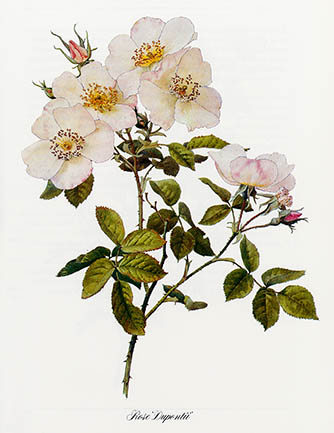| Rosa dupontii written by Ellen Willmott
ROSA DUPONTII Déségl.

Rosa Dupontii: caulibus erectis; aculeis obliquis, sparsis, falcatis, aciculis intermixtis, foiliolis 5, magnis, oblongis, acutis, subcoriaceis, facie viridibus, glabris, dorso pubescentibus; shachi pubescente, modice glandulosa; stipulis adnatis, glanduloso-ciliatis, apicibus liberis ovato-lanceolatis; floribus multis, corymbosis; pedicellis elongatis, glandulosis; bracteis lanceolatis; calycis tubo oblongo, lobis acutis, dorso nudis, glanduloso-ciliatis, exterioribus pinnatifidis; petalis albis; stylis in columnam breviter protrsam coalitis.
R. Dupontii Déséglise in Mém. Soc. Acad. Maine-et-Loire, vol. x. p. 58 (Ess. Mon. Ros. P. 18) (1861); in Bull. Soc. Bot. Belg. Vol. xv. P. 206 (Cat. Rais. Ros. P. 37 [1877]) (1876).
R. damascena, var. subalba Thory in Redouté, Roses, vol. i. P. 63, t. (1817).
R. moschata, var. nivea Lindley in Bot. Reg. vol. x. t. 861 (1824).
R. moschata, var. rosea Seringe in De Candolle, Prodr. vol. ii. P. 598 (1825).
R. nivea Hort. Paris.
An erect bush 3-4 feet high. Prickles slant, hooked, scattered, mixed with aciculi. Leaflets 5, oblong, acute, large, subcoriaceous, green and glabrous above, paler and pubescent beneath; petioles pubescent and slightly glandular; stipules adnate, gland ciliated, with ovate-lanceolate free tips. Flowers many, corymbose; petioles long, glandular; bracts lanceolate. Calyx-tube oblong, lobes ≤-1 in. long; lobes acute, naked on the back, gland-ciliated, the outer pinnatifid. Expanded petals pure white, buds red outside. Styles united in a shortly protruded column.
---------------------------------
The Musk Rose is one of the old-fashioned flowers which greatly contributed to the charm and beauty of English gardens in former days. More fortunate than many another pretty Rose, it never completely disappeared, so that when the fancy for single Roses returned it was soon restored to favor.
Various accounts are given of its origin, but it is difficult to say with any degree of certainty whence it came. The beautiful drawing called Rosa damascena subalba in Redouté's Roses is accompanied by a description of the Musk Rose, which is said to grow in southern Europe, and to be indigenous to Spain. The writer concludes his account by remarking that its graceful growth and the beauty and profusion of flowers will well repay those who procure it for their gardens. This was in 1817. Seven years later an excellent drawing of the Rose under the name of Rosa moschata, var. hort. nivea, the Snow-white Musk Rose, appeared in Botanical Register. In the accompanying description Lindley says that it is the most beautiful single rose he knows, and that it was raised by French grower Dupont. The drawing was made from a plant growing in the garden of the Horticultural Society at Chiswick, whither it had been sent from Versailles by De Pronville, who had recently published an excellent French translation of Lindley's Monograph, containing much additional information about Roses.
William Paul, writing about the Musk Rose in the Rose Garden, says that it is common in Madeira and the north of Africa and is also found in Persia, and that, having been introduced to England about the year 1596, it has by reason of its long residence among us become widely spread throughout the country. He enumerates twelve hybrids by name (1). The American writer Parsons (2) says that the Musk Rose grows naturally in Persia and other eastern countries, where it sometimes attains dimensions of a small tree, and it is doubtless the Rose which has been celebrated by eastern poets. He mentions a plant in his own garden which has withstood the rigour of twenty New York winters. According to Rivers (3), Olivier, who traveled in the first six years of the French Republic, describes a Rose-tree at Ispahan clled the "Chinese Rose-tree", which was fifteen feet in height and was formed by the union of several stems, each four or five inches in diameter. Seeds from this tree where sent to Paris, where they produced the common Musk Rose.
Déséglise considers that Rosa Dupontii differs from the type Rosa moschata Mill. In having glabrous calyx and sepals, and leaves which are oval and pubescent on the under side. He gives its period of flowering as June, and its habitat as Maine-et-Loire, and says that Boreau found a specimen growing in a hedge near Angers. This hedge was afterwards destroyed, but the bush was transplanted to the Botanic Garden. Boreau's plant disappeared during the changes which the garden has undergone since his time and no trace of it can now be found.
1. Rose Garden, pt. 2. p. 150 (1848)
2. The Rose, p. 262 (1847).
3. Rose Amateur's Guide, ed. II. P. 155 (1877).
Text from The Genus Rosa by Ellen Willmott, 1910
photo of R. x dupontii
www.RoseGathering.com
|













